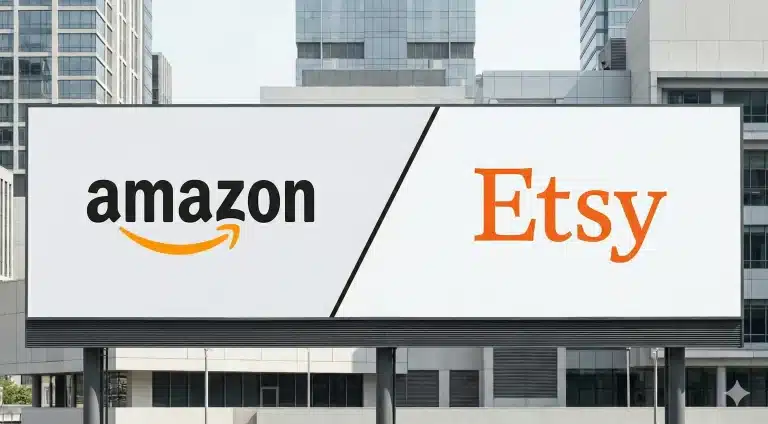
How Multi-Marketplace Selling Unlocks Growth Beyond Amazon
Why do smart sellers opt for multichannel selling?
When we talk about e-commerce marketplaces, the name that dominates is Amazon. It is impossible to ignore this giant, which makes it the seller’s go-to marketplace. However, the dynamics have changed in the last few years. The transition and diversification into other marketplaces is gaining momentum.
Regarding dominance, Amazon holds around 10–15% of the global market share. While Amazon continues to dominate the market, competitors such as Walmart, eBay, and Shopify have captured significant market share.
Now, sellers are choosing platforms beyond the Amazon ecosystem, helping them expand their global footprint. In this blog, we will explore why expanding beyond Amazon is a strategic move and reveal how automation tools make multi-channel selling more straightforward and more profitable than ever.
Limited Growth with a Single Entity – Amazon
Sellers who are solely enterprising through Amazon are experiencing low sales and stagnation. Rather, their capital outflow exceeds their ROI. Just as you cannot earn higher returns by investing in a single high-performing mutual fund, you cannot achieve rapid and wider growth through a single entity. The uncertainty factor also plays a key role.
High Competition and Fee Pressure
Amazon hosts millions of sellers offering similar products, leading to competition for similar keywords. Competing on price and visibility alone can quickly erode margins. Additionally, rising fulfillment and referral fees and profitability may shrink further.
Risk of Account Suspension
Amazon follows strict seller policies designed to be more customer-focused. Even minor issues, such as a delayed shipment or a negative review, can lead to account suspension, resulting in slow recovery and the entire business coming to a halt.
Limited Brand Identity
Amazon is an excellent platform for sales, but brand awareness is almost negligible. Who remembers what brand of item they bought? Customers only remember Amazon, unless you build your own channels.
Restricted Market Reach
You miss out on tapping into another valuable customer base by restricting your brand to Amazon. With expansion into multiple channels, the potential to reach a wider audience across the market increases. Every marketplace attracts a unique buyer profile. For example, eBay users can buy new and used items; at Walmart, customers often look for value-driven products; and at Shopify, buyers can engage directly with brands.
Genuine Sellers Who Grew by Diversifying: Case Examples
When deciding on the right platform for your brand’s sales, the best practice is to study the success stories. Let’s look at how smart sellers used marketplace diversification to multiply their sales and brand visibility.
Case 1- Big wins for Seven Times Six on the Walmart Marketplace site.
A company (Seven Times Six) used Walmart’s multi-channel solutions to enable shipping and integration across multiple platforms (Amazon, eBay, etc.) via Walmart’s APIs.

The brand expanded beyond Amazon by integrating with Walmart’s multi-channel logistics and APIs, enabling orders from its website and eBay, thereby reducing its dependency on a single marketplace.
Within six months:
• 50% reduction in delivery time to customers.
• 3,000+ orders shipped during peak season.
• 15% reduction in shipping cost, compared to competitors
Case 2 – Revenue increased by 12 times for a US-based Oven company.
An oven company that initially sold only on eBay integrated its portfolio across multiple retailers and e-tailers. They’ve expanded their presence to over 40 integrations across 20 platforms.
Result: Within a year,
• Revenue increased 12x without any media spend.
• SEO and online presence improved significantly.
• An increase in brand credibility and exposure featured them on the Ellen Show, leading to further business growth.
This case illustrates the power of listing products across multiple platforms and the potential for exponential growth.
Success Factors for Expanding to Other Marketplaces
A shift from a single marketplace to multiple channels is a powerful growth strategy. How can it transform your eCommerce game?
Expanded Customer Reach
The advantage of multi-channel selling is that it offers extensive market reach and brand discovery.

The most high-performing ecommerce brands, such as Walmart (United States & Canada), eBay (United States, United Kingdom, Germany, China, and Australia), and Shopify (US, UK, Canada, and Australia), have strong market presence and offer distinct growth opportunities.
Brand Visibility and Credibility
A brand visible on platforms like Amazon, Walmart, and eBay is more established, trustworthy, and credible in the eyes of the buyer.
Reduced Risk
Choosing multiple selling channels keeps the sales going, even in the case of platform policy changes, portal downtime, or reduced organic reach.
Consumer Insights
Analytics dashboards share data on buyer trends and product performance across channels, helping brands refine their inventory and marketing strategy.
Boosting the Revenue Graph
Automation tools simplify listing management, enabling multi-channel sellers to achieve up to 50% higher sales.
Capitalizing on Automation Tools for Expansion
Automation simplifies operational tasks and synchronizes data, allowing the brand to focus on growth. So, there is less worry about managing listings, prices, and inventory across multiple marketplaces.

5 Ways to make expansion fluid and scalable:
a. Centralized Inventory
Using a centralized inventory tool prevents overselling and provides real-time stock-level updates. Willow Commerce, Sellbrite, ChannelAdvisor, and CedCommerce are such tools that help monitor your inventory across Amazon, Walmart, eBay, and Shopify.
b. Automate Order Fulfillment
The automation software helps orders from different platforms flow into a single dashboard, ensuring quick, error-free dispatch and customer updates.
c. Optimize Listings for Each Marketplace
Automation makes your onboarding process easier and faster. It helps bulk-upload products by customizing and adjusting product titles, keywords, and descriptions to suit each platform’s search algorithms and audience preferences.
d. Single Dashboard for Performance Analytics
Gaining critical analytical information, such as identifying the channel driving the highest ROI, is a big plus for a seller. A unified analytics dashboard helps track sales, conversions, and ad performance across all platforms.
e. Consistent Branding Across Platforms
Implementing unified branding across different platforms is essential for achieving brand recognition and maximizing customer engagement. Using templates and automation for product visuals, pricing strategies, and promotions allows you to synchronize brand assets while accommodating the specific needs of local audiences.
Interconnected Multi-Channel Presence
Building a robust and connected ecosystem involves strategic diversification to multiple seller platforms.

Here are a few key factors that play an essential role for starters:
1. Start by selecting 2 to 3 high-performing channels.
2. Ensure consistent branding across channels to enhance visibility and recognition.
3. Utilize social commerce by integrating platforms like Instagram, Facebook, and other relevant social media channels.
4. Maintain uniform pricing and policies across all channels to build trust and prevent confusion for customers browsing multiple platforms.
5. Implement AI chatbots or CRM integrations to handle queries from various sources efficiently.
Multi-Channel Diversification – A Go/No-Go Decision
Reaching a potentially strong, untapped market for your brand is possible only if you step outside the Amazon ecosystem. It is a strategic move that leads to significant growth and profitability, enables you to capture potential buyers, improves SEO, and manages risk. It offers adaptability, which becomes an engine for growth through broader reach, higher brand value, greater leverage in less competitive spaces, and more resilient revenue streams.
It’s a typical go/no-go decision. Choose wisely to make your brand into a multi-market powerhouse.
» Start Your Free Trial


